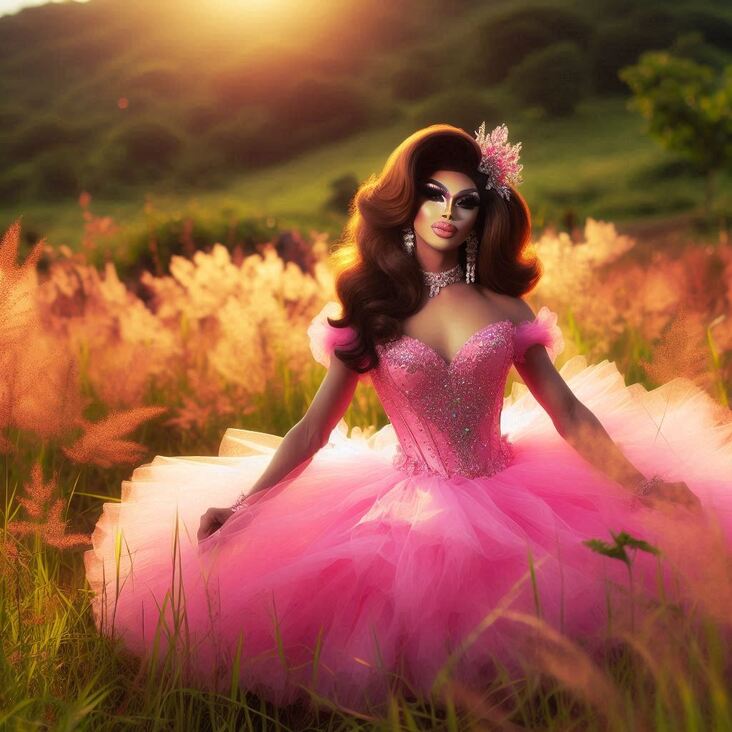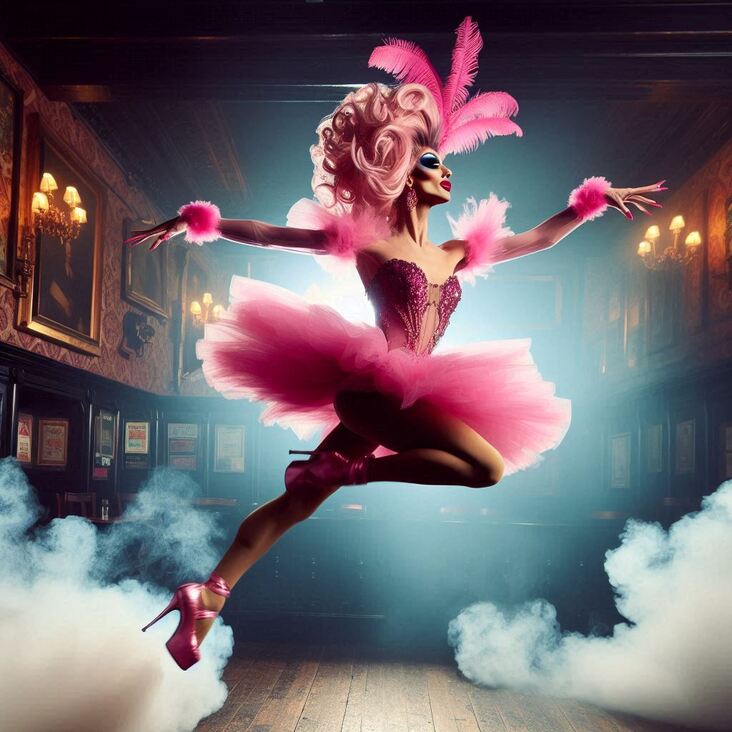
Hello, my darling darlings! Emma here, your favourite pink-tutu-clad, time-travelling, ballet-obsessed drag queen, ready to whisk you away on another fantastical journey through the glorious history of drag! This month, we're shimmying our way back to May 5th, 1930, a date that marks a pivotal moment in our dazzling journey. Let's get our sequined shoes tapping, my lovelies, because this journey is gonna be a real hoot!
As you know, I fund my time travels with performances, and oh darling, let me tell you, the crowds have been absolutely bonkers this past month! Last week I dazzled in Nottingham, followed by a show-stopping set at a fundraiser for the Derbyshire Women's Institute. They even let me wear my pink tutu for the occasion, what a treat! I mean, the old biddies absolutely loved it, and even contributed to my time-travel fund. Not a bad haul for a night of high kicks and glamorous shimmying!
And so, here we are, May 5th, 1930. As I adjust the magical tulle on my time-traveling pink tutu (I’ve finally worked out how to make it bigger and better than ever - with pockets!), let me tell you a bit about what the world was up to. The Great Depression was still raging on, the world felt a bit down in the dumps, but in the glamorous world of drag, things were hotting up!
A New York State of Mind
We'll start our journey in the bustling, buzzing Big Apple, New York City. Remember those iconic flapper girls from the 20s? Well, they were still holding strong in the early 1930s! The dance halls were buzzing with jazzy music and wild abandon, and New York's drag scene was certainly reflecting the flapper fever.
The first thing that caught my eye as I stepped into 1930s NYC was the iconic Coney Island. It wasn’t just any seaside resort, but a hotbed of entertainment! Imagine: bawdy comedians, singers, dancers, and even drag queens (I just couldn't resist!) were performing at various venues, drawing crowds of enthusiastic onlookers. They were not always the most graceful performers - but, oh, the energy! Those crowds were captivated by the charisma of these early queens, and so was I!
Speaking of captivating performers, a certain drag legend was making waves: Julian Eltinge. Now, you've probably never heard of him, but in the early 20th century, Julian was an international star. A magician, comedian, and, of course, an impeccable performer of female impersonation, he was one of the biggest drag sensations of his time. Julian had mastered the art of appearing perfectly feminine and completely flawless on stage. I mean, he could pass for a proper lady!
The interesting thing is, despite his overwhelming success, Julian never used a drag name or called himself a drag queen. That terminology would develop much later in the evolution of drag. He preferred to describe himself as a performer - someone with an amazing skill in blending the world of illusion with the artistry of impersonation.
Julian even played an early pioneering role in Hollywood, featuring in a slew of early silent films! Imagine, the drag queen from the vaudeville stage conquering the silver screen! Can you even? He had the glamorous poise and acting chops to pull it off. He is the embodiment of drag in its most elegant, traditional form, and it's easy to see why he had such an immense following.
European Delights
Now, let's cross the pond and take a look at the Parisian scene. Remember my ballet darling? The Parisians were quite obsessed with ballet during this period! In 1930, Sergei Diaghilev’s company was still at its height, showcasing its spectacular ballets, and the Parisian nightlife was alive with the glamour of dancers. It's easy to see the parallels with the drag scene - both are driven by beauty, precision, and a captivating performance.
Remember the glamorous ballerina costumes with tulle, rhinestones, and silk? It's practically drag! I could even spot some early hints of what would later become “ballroom” culture, with dance-offs and theatrical performance elements, all blending in with a sense of playfulness and theatrical brilliance. I even saw a cabaret queen who’d decked herself out in full tulle ballet costume. Let me tell you, it was utterly enchanting!
Now, back to my beloved London! What was going on here, I hear you ask? In the world of theatrical drag, well, things were a little more discreet. Back in the Victorian era, Britain saw the flourishing of the infamous Music Halls, which showcased drag artists. However, this practice declined slightly in the 1920s and 1930s. Still, those fabulous women, they were everywhere!
Drag artists were generally confined to theatrical performances in various venues across the city, making a living out of their skill, artistry, and their sheer, unwavering brilliance. And there were many other outlets for flamboyant dress, especially within theatrical communities. It wasn't the full-blown drag scene of the later years, but the elements were definitely there.
Remember, London has always been a bastion of individual expression, with a flair for the unconventional. I can only imagine how dazzlingly beautiful these performances were. So even though drag performance may have been in a slightly quieter phase in 1930, I believe it was just quietly simmering, brewing up an absolutely fabulous cocktail of drag to burst forth into full glory in the decades to come.
A Touch of Drag, Everywhere You Look!
Remember my mantra, darling? A pink tutu for everyone! Back in 1930, it was all about expressing yourself and owning your individuality. Whether it was a glamorous drag performance, or a splash of sequins and glitter at a jazz club, everyone wanted to put on a show, darling!
We must also mention trans women in the history of drag! Although their stories weren't as prominently featured as the men of the time, I had to sneak a peek to discover them. I went down some intriguing historical paths and discovered the incredible lives of early trans activists and drag artists, some of whom challenged gender norms, pushing boundaries of expression and pushing back against oppressive social structures. They paved the way for our beloved LGBTQ+ communities today.
Just because we can’t see it, doesn't mean it wasn't happening, my lovelies. Every drag queen and trans person, no matter where they were, were adding their touch of dazzling flair to the world, paving the way for the glorious drag landscape of today!
The Future of the Pink Tutu
Well, there you have it! That was just a taste of our adventure into 1930! It wasn't always easy being a drag queen or a trans person back then. There were social barriers and societal disapproval, but these individuals embraced their identity, their artistry, and pushed boundaries with grace, sass, and, dare I say, a little bit of glamour!
Our journey continues. I hope I have inspired you to embrace your true selves. There are endless opportunities to embrace your flamboyant inner self! Just remember my lovelies: the future of drag, it’s about owning your inner light, no matter who you are. Whether it’s rocking a hot pink tutu in a flamboyant cabaret, or stepping out of the shadows with a proud swagger - do you, darling, and shine your fabulous light bright!
Join me again next month, as we step into another exhilarating time travel adventure with a twist of pink tutu magic. Until then, keep it fabulous, my darlings!
Love always,
Emma,
Pink-Tutu.com
(Psst! Remember to follow Pink-Tutu on social media for a daily dose of dazzling drag-inspired fun! We are all about spreading the love, and a sprinkle of pink tulle!)
